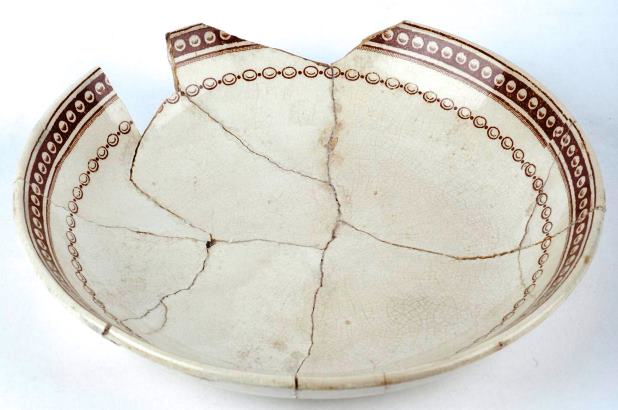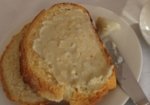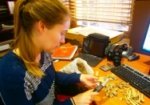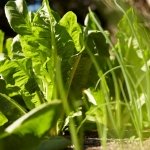Archaeology Honours reasearcher Kim Connor joins us again with her recreation of a typical dinner served to women living in Hyde Park barracks in the Destitute Asylum and Immigration Depot in the 1880s.
If breakfast and supper in the Destitute Asylum and the Immigration Depot were boring and repetitive, dinner (served at 1 pm) was the one opportunity in the day for a bit of variation. the meat the women were given was generally beef or mutton, which was sometimes roasted but more often boiled. When boiled, the women would have soup made from the cooking liquid, with vegetables and seasonal herbs added (potatoes, pumpkin, cabbage, carrots, turnips, parsnips, leeks, marjoram, thyme and parsley are all mentioned) and a bit of barley or flour to thicken it.
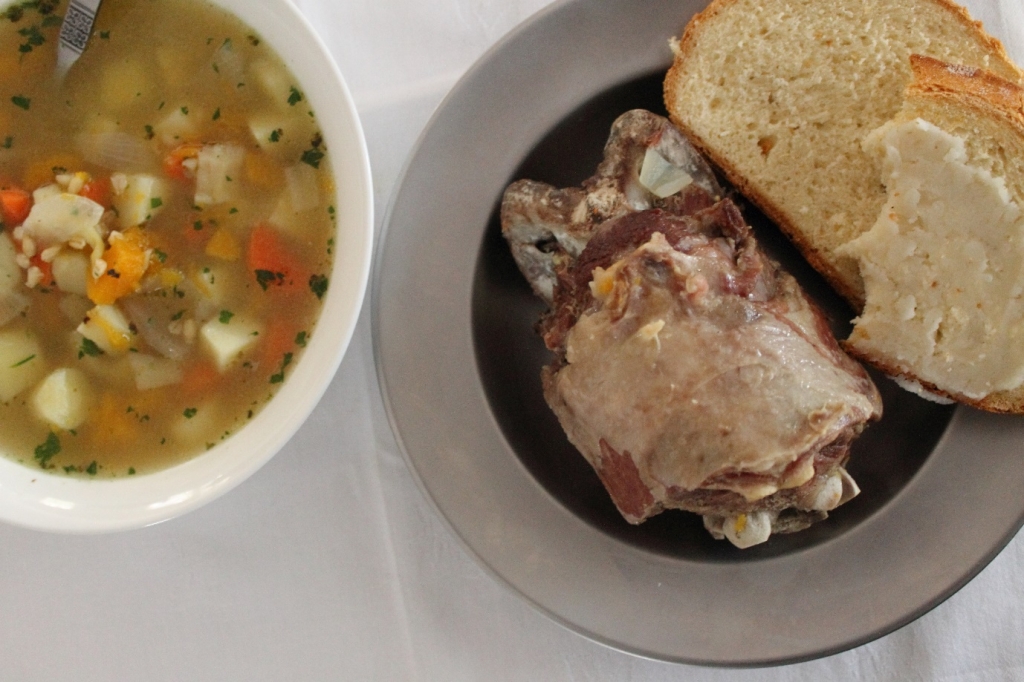
Recreated dinner for the Destitute Asylum: soup, boiled meat and bread with dripping. © Kim Connor
A first-hand description
In 1887, just after the Asylum moved from Hyde Park Barracks to Newington the head cook from the barracks, Mary Rooney, was asked to explain how she made the soup. First she would boil the tougher cuts of meat in the copper, then she would add the better meat cuts with the vegetables. She used a nicked stick to show how much water needed to be added, and the soup would boil for about two hours. Any fat would be skimmed off the top for the women to eat with bread, and a little barley or flour added to thicken the soup. [1]
Legs, Ribs and Scrag-ends
Archaeology can also tell us some useful information about the types of meat that were being eaten on the site. The majority of bone on the site comes from sheep or goats. Most of these animals are probably sheep, but because it is difficult to tell the two apart skeletally they have been treated as one category in my Honours thesis.
Sheep/goat atlas, one of the vertebrae in the neck, from a meat cut called the scrag end or neck. Hyde park Barracks collection #UG2162. Photo © Kim Connor for Sydney Living Museums
The most common parts of the skeleton which we have found in the archaeological remains are ribs and vertebrae, and these could come from a range of cuts of meat, some more recognisable than others. We found 19 sheep or goat atlases and axes (vertebrae from the very top of the spine) and these probably come from a cut called a ‘scrag-end’.
Scrag-ends are a cheap cut with a lot of bone and not much meat, but we also found evidence of cuts with a lot of meat. We identified 32 humerus fragments and 20 femur fragments from sheep or goats, which probably come from legs or shoulders of mutton. It’s interesting that we found very few fragments from the skull, which would be one of the cheapest cuts. This suggests that the barracks was being supplied with a variety of different cuts of meat, but that there was no official policy of providing poor quality or cheap meat.
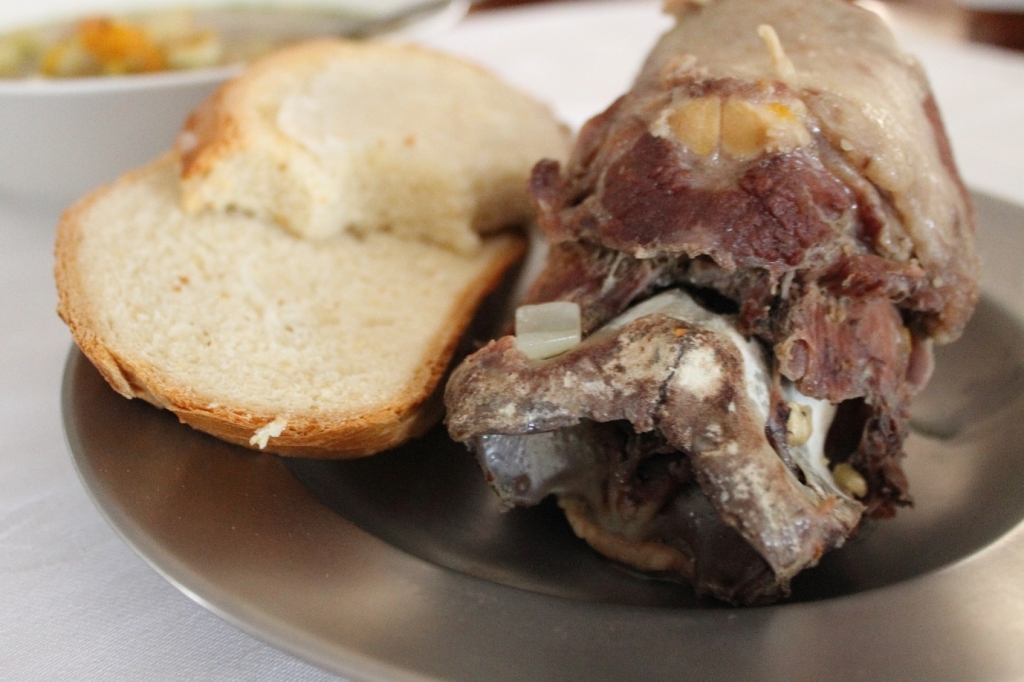
Scrag-end for dinner, note that you can see the atlas poking out at this end. © Kim Connor
Re-creating the Soup
To support the firsthand information given by the barracks’ cooks about the soup, I consulted Alexis Soyer’s recipe for Mutton Broth as a useful guide; Soyer was an influential 19th-century chef who turned his attention to feeding the poor, the sick and institutionalised, and army troops:
Any description of trimmings of mutton may be used for broth, but the scrag ends of the neck are usually chosen. Put two scrags into a stew-pan (having previously jointed the bones), with three onions, three turnips, and one carrot; fill up the stewpan with a gallon of water, and place it upon the fire; when boiling set it at the corner, where let it simmer for three hours, keeping it well skimmed; then cut a small carrot, two turnips, an onion, with a little leek and celery, into small square pieces, which put into another stewpan, with a wineglassful of pearl-barley, skim every particle of fat from the broth, which pour through a hair sieve over them; let the whole boil gently at the corner of the fire until the barley is tender, when it is ready to serve; the meat may be trimmed into neat pieces and served with the broth, or separately with melted butter and parsley, or onion sauce. Half or even a quarter of the above quantity can be made by reducing the ingredients in proportion.[2]
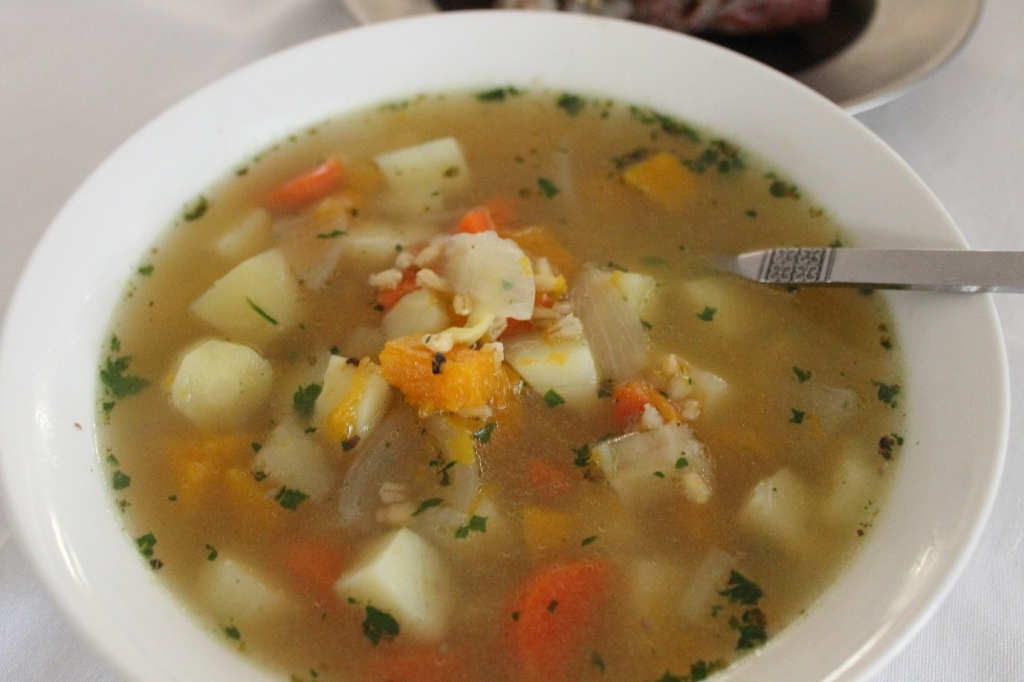
Kim Connor’s Asylum soup. Photo © Kim Connor
Asylum Soup
Makes 3 historical servings, which are very large. Note that no salt is added to the recipe, but it was on the table for people to add as much as they liked.
1.35 kg of mutton, beef and/or lamb, cut into pieces about 450g each;
1.35 kg mixed vegetables (potatoes, carrots, onions, leeks, pumpkin, cabbage, parsnips or turnips)
A small handful of fresh parsley, marjoram and/or thyme, finely chopped
160g pearl barley
Pepper
Take any onions or leeks and half the carrots that you are using and chop roughly. Place them in a large stockpot with the meat and cover with water. Bring to the boil and allow to simmer for 1.5 hrs, regularly skimming off any fat from the top with a slotted spoon.
Dice the remaining vegetables and add them to the pot. Stir in the barley, and allow the soup to cook for another 30 mins.
Remove the meat. Season the soup with pepper and serve hot. The meat should be served in a separate dish.
Notes on ingredients
Mutton can be hard to find these days, so if using lamb, you could use beef or a combination of beef and lamb. In keeping with archaeological finds, I used scrag-end and two lamb shanks (each roughly 1 lb. or 450 g in weight). Your butcher may call scrag-ends necks, and make sure that you get a whole one and not neck chops.
If preferred, you can boil the potatoes separately, and serve them with the meat.
If using flour instead of barley to thicken the soup, towards the end of cooking, take a few tablespoons of flour and whisk them with a little of the hot liquid to make a paste, stir it into the soup and continue stirring until the soup thickens.
As described in my previous bread and dripping post, the historical documents are very clear that the fat should be skimmed off the top of the soup as it is cooking, so that it can be eaten with bread. This is a time consuming and frustrating process, but it is worth doing to really recreate the experience. I found that I was able to skim off enough of the bubbles of fat which appeared on the surface with a slotted spoon to make a fair amount of dripping, but there is no need to get every bit of it.
[1] NSWLAVP, “Report of the Government Asylums Inquiry Board; Together with Minutes of Evidence and Appendices” (Sydney: NSWLAVP, v 1887), 478–79.
[2] Alexis Soyer, The Modern Housewife: Or, Ménagère. Comprising Nearly One Thousand Receipts, for the Economic and Judicious Preparation of Every Meal of the Day, and Those for the Nursery and Sick Room; and Minute Directions for Family Management in All Its Branches. Illustrated with Engravings Including the Modern Housewife’s Unique Kitchen, and Magic Stove (London: Simpkin, Marshall & Company, 1851), 112–13.
